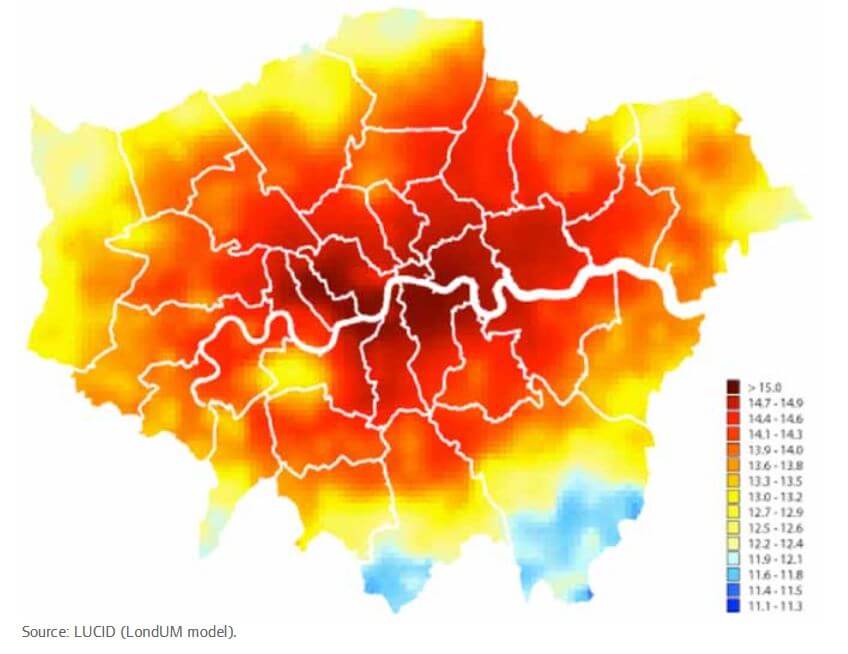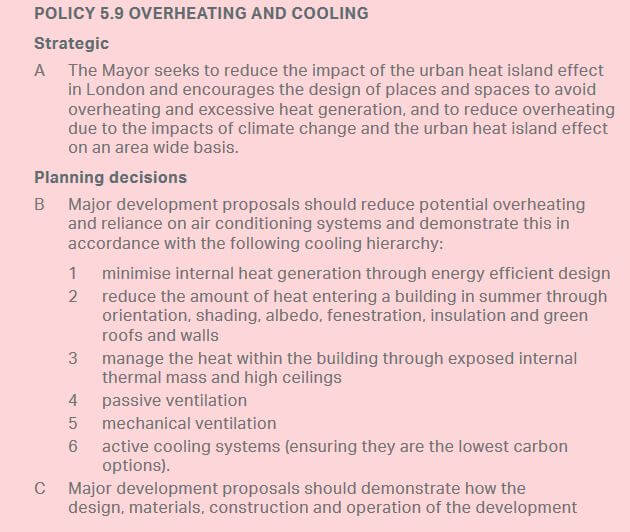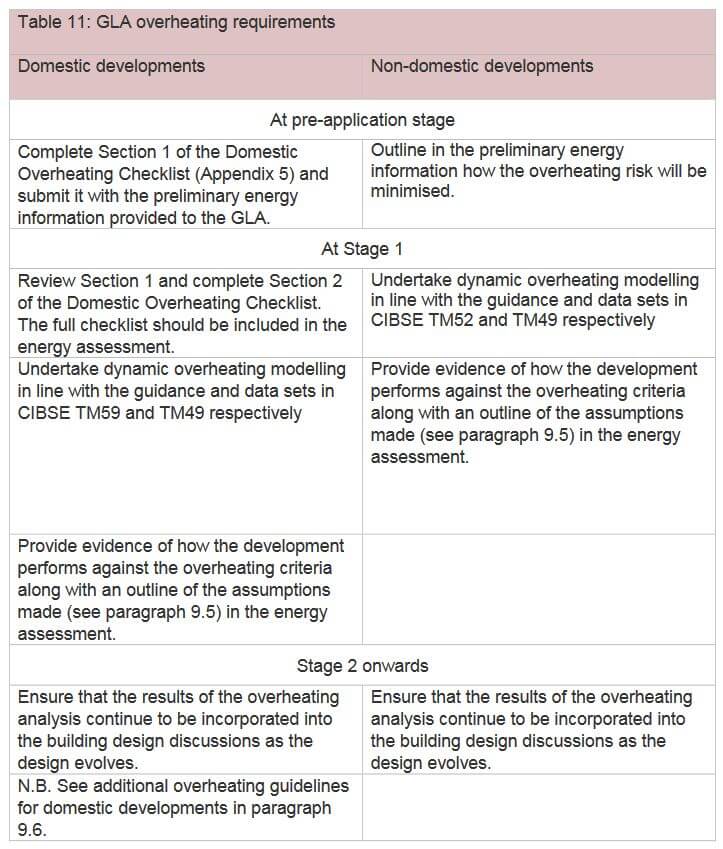CIBSE TM49: Design Summer Years for London
When it comes to using real weather data (such as CIBSE’s Test Reference Years and Design Summer Years) in dynamic simulation building modelling, London is something of an anomaly. Due to its large size, density and population, London suffers from a phenomenon known as the Urban Heat Island effect.
The Urban Heat Island Effect
The Urban Heat Island effect is where a city is significantly warmer than the surrounding rural areas due to human activities such as heavy traffic, large amounts of buildings and paving (which absorb solar radiation and block cooling winds) and air conditioning systems, which exacerbate the problem further as they expel heat from buildings to the outside in order to keep them cool during the warmer months.

The heat map above is taken from the Mayor of London’s Climate Change Adaption Strategy, October 2011 and shows the average daily minimum temperatures for London between the 26 May to 19 July 2006. It is quite clear to see that the closer you get to central London the higher the temperature becomes.
Now you may be thinking that a rise of just one or two degrees centigrade may seem insignificant but even the slightest increase above typical external temperatures can have a huge impact on the people and infrastructure of London.
Higher external temperatures can mean that train lines start to buckle and road surfaces begin to melt. There will be an increased usage of water and cooling energy within buildings, this also creates a negative feedback loop, as the air conditioning system will therefore be expelling more heat to the outside.
For people, higher temperatures can affect sleep at night and cause heat strokes during the day. This can be fatal for people at higher risk such as the elderly, the August 2003 heat wave alone caused an estimated 600 deaths.
It is clear to see that overheating is already a serious issue facing London and any new potential building development, however with the estimated impact of climate change, without any intervention this issue is predicted to get considerable worse in the future.
What can be Done?
In order to reduce the impact of the urban heat island effect Policy 5.9 of the London Plan states that developments should follow the design rules known as the ‘cooling hierarchy’ to reduce the amount of cooling required or remove the need for it entirely. The cooling Hierarchy is as follows:
- Minimising internal heat generation through efficient design.
- Reduce the amount of heat entering a building in the summer through orientation, shading, insulation and green roofs.
- Manage the heat within the building through exposed internal mass and high ceilings.
- Passive ventilation.
- Mechanical Ventilation
- Where mechanical cooling is still required, ensure that it is the most efficient type.

The London Plan also asks that developments make the fullest contribution to London’s adaption to climate change and they should be designed to account for warmer, wetter winters and hotter, drier summers, both now and over 50 years into the future.
The Mayor’s Climate Change Adaptation Strategy, Sustainable Design and Construction SPG guide, and the Greater London Authority guidance on preparing energy assessments all ask that dynamic simulation modelling is carried out to ensure that developments account for future climate change scenarios.
The London Guidance on Preparing Energy Assessments has actually just been updated this month (October 2018) and the full document can be found here. The guidance now asks that all major residential developments undertake dynamic overheating modelling in accordance with CIBSE TM59, and non-domestic in accordance with CIBSE TM52. Both of these assessments would need to use the weather data sets found in CIBSE TM49.

What are the CIBSE TM49 DSY’s for London?
The GLA, working alongside CIBSE, created TM 49: Design Summer Years for London – 2014. These specially created DSY weather files take into account future predicted summer temperatures based on a range of emission scenarios, the effect of the urban heat island and the fact that health impacts increase with rising temperatures.
As we mentioned earlier London is an anomaly when it comes to weather. The original CIBSE DSY weather data for London didn’t take account for the Urban Heat Island effect as it used only one data set taken from the Heathrow area. The new CIBSE TM49 weather data sets have 3 different locations, so the one most appropriate for the development can be selected. These are:
- Central London (An urban environment)
- London Heathrow (A Suburban environment)
- London Gatwick (A more rural environment)
The DSY weather files are then each split a further 3 times to enable the simulation of different summer conditions and the impact each one could have on a developments peak summer time temperatures and cooling ability. These are:
- DSY 1 – A Moderately Warm Summer.
- DSY 2 – A Short, Intense Warm Spell.
- DSY 3 – A Long but Less Intense Warm Spell.
This allows the predictive internal temperatures and cooling energy for the development to be analysed under different summer environments. To determine if the development is likely to suffer from overheating during any of these summer conditions the overheating the methodology for computer simulations set out within CIBSE TM52 should be used.
Finally to determine how the development will handle the impact of climate change, future DSY weather files for London can be used. The future weather files also take into consideration low, medium and high carbon emission scenarios. Allowing for a complete range of simulations to be undertaken given you a clear indication of how the development will react to climate change. The future DSY weather files available are:
- 2020s – High Emissions Scenario – 10th, 50th, 90th percentile
- 2050s – Medium – 10th, 50th, 90th
- 2050s – High – 10th, 50th, 90th
- 2080s – Low – 10th, 50th, 90th
- 2080s – Medium – 10th, 50th, 90th
- 2080s – High – 10th, 50th, 90th
How we can Help?
At EEABS we can create a dynamic simulation model of your building and use the CIBSE TM49 weather files to accurately assess any overheating likely to occur for any location within London, type of summer and climate change scenario.
The overheating simulations run will be in accordance with the methodology set out within CIBSE TM59 for residential builds or CIBSE TM52 for non-domestic builds, as requested by the London Plan.
Using the same dynamic simulation model we can extend our services to produce a full London Plan Energy Assessment for the development. Analysing the carbon emissions through each stage of the energy hierarchy (Be Lean, Be Clean, and Be Green) and provide cost effective advise as to how you can meet a 35% carbon reduction over the current Building Regulations requirements.
If you require any overheating simulations to be run, a full London Plan Energy Assessment or just have any questions please call or email us today.



